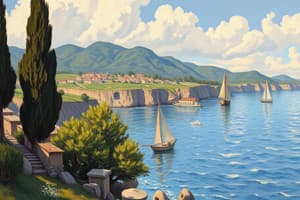Podcast
Questions and Answers
Which of the following characteristics is true for the Northeast (New England)? (Select all that apply)
Which of the following characteristics is true for the Northeast (New England)? (Select all that apply)
- Big cities/towns (correct)
- Cold winter/warm summers (correct)
- Hot summers/warm winters
- Great soil
What is the climate like in the Southeast?
What is the climate like in the Southeast?
Hot summers/warm winters
The Midwest region has great soil suitable for farming.
The Midwest region has great soil suitable for farming.
True (A)
The ______ region has variable climate and includes deserts, mountains, rivers, and the ocean.
The ______ region has variable climate and includes deserts, mountains, rivers, and the ocean.
What ocean is the Pacific Northwest located by?
What ocean is the Pacific Northwest located by?
Which of these characteristics belong to the Southwest region? (Select all that apply)
Which of these characteristics belong to the Southwest region? (Select all that apply)
The Northeast region had a significant amount of slavery.
The Northeast region had a significant amount of slavery.
Name one major river in the Midwest region.
Name one major river in the Midwest region.
Study Notes
Northeast or New England
- Characterized by a cold winter climate and warm summers.
- Contains rocky soil, making farming challenging.
- Bordered by the Atlantic Ocean which contributes to its economy.
- Hosts large cities and towns, contributing to its significant population.
- Economy relies on lumber, fur, and fishing industries, benefiting from fast-moving rivers.
- Notably had little to no slavery in historical context.
Southeast
- Features hot summers and warm winters creating a distinct climate.
- Contains slow-moving rivers, affecting transportation and agriculture.
- Known for great soil quality which supports extensive farming.
- Located by the Atlantic Ocean, enhancing trade and accessibility.
- Predominantly rural with fewer towns and cities compared to other regions.
- Historically, this region practiced slavery, influencing its social and economic structures.
Midwest
- Experiences a climate of cold winters alongside warm summers.
- Notable for having rich soil ideal for agriculture.
- Comprised mainly of flat lands, known as Central Plains.
- Geographically situated between the Appalachian Mountains and the Rocky Mountains.
- Major rivers include the Mississippi, Ohio, and Missouri, important for transport and trade.
- Features the Great Lakes, significant for commerce and recreation.
- Initially settled by French explorers, shaping early American development.
West
- Stretches from the Rocky Mountains to the Pacific Ocean.
- Includes significant mountain ranges such as the Sierra Nevada.
- Contains diverse geographical features including interior plateaus, deserts, and rivers.
- Experiences a variable climate, contributing to its rich biodiversity and land use.
Pacific Northwest
- Defined by a cool climate with high levels of rainfall.
- Features numerous rivers and dense forests, contributing to its natural beauty and resources.
- Land is noted for its abundance and productivity, supporting various industries.
- Directly adjacent to the Pacific Ocean, promoting maritime activities.
Southwest
- Characterizes a hot, dry climate influenced by desert landscapes.
- Home to the Grand Canyon, one of the natural wonders of the world.
- Region includes lands acquired from the Mexican-American War, shaping its historical context.
Studying That Suits You
Use AI to generate personalized quizzes and flashcards to suit your learning preferences.
Description
This quiz explores the unique characteristics of various U.S. regions, including the Northeast, Southeast, and Midwest. It covers climate, geography, economy, and historical context, such as the role of slavery. Test your knowledge of how these diverse regions contribute to the identity of the United States.




